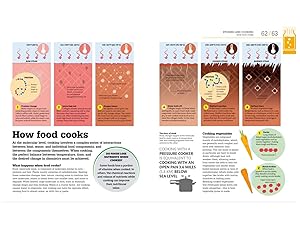How Food Works: The Facts Visually Explained (How Things Work)
Price: $9.99
(as of Dec 05, 2022 19:01:22 UTC – Details)
Let this guide be your very own friendly nutritionist, on hand to debunk common food myths and give you the answers to those pressing health questions with easy-to-swallow information.
Is red wine good for your heart? Will caffeine raise your blood pressure? How Food Works gives you answers to these and several more questions by investigating claims surrounding a variety of foods and examining them from a biological standpoint. Discover nutritional facts about the food you eat, learn the benefits of superfoods and antioxidants, and go behind-the-scenes of modern food production.
Packed with infographics and colorful images, the book delves into the science behind ways of eating including gluten-free and veganism, as well as the benefits of different diets from around the world. Turn the pages to understand why food intolerances occur, what actually makes food organic, how important sell-by dates really are, and how much salt you should really be eating.
Readers will also learn about the social and economic implications of food choices, such as eating disorders and fair-trade businesses.
Indispensable and accessible to young and old, How Food Works is the perfect health and dietary companion.
From the Publisher


Chilies and Other Hot Foods
Prized for adding kick to dishes, chili peppers and other hot or pungent foods, such as mustard and horseradish, come armed with powerful chemical defenses that we can use for flavor and may also prove to have health benefits.






What are Convenience Foods?
Convenience foods are preprepared or processed and include prepackaged meals, cake mixes, snack foods, preprepared fruit and vegetables, frozen ingredients, and canned food. Companies that make and sell convenience foods usually focus on taste and shelf-life rather than on nutritional value.
What are Whole Foods?
Whole Foods are the opposite of processed foods—they are in their natural form, or processed as little as possible. They might include fresh fruit, vegetables, meat, fish, whole grains, nuts, and seeds. Some proponents argue whole foods must also be organic, but there is little evidence for that health benefit of organic foods.
How Food Cooks
At the molecular level, cooking involves a complex series of interactions between heat, water, and individual food components, and between the components themselves. When cooking, the perfect balance between temperature, time, and the desired change in chemistry must be achieved.


Sources of Fats and Oils
Oils are fats that are liquid at room temperature, although the terms are often used interchangeably. Those that you get through your food are called dietary fat.






Types of Vegetable Fruits
Vegetable fruits belong mainly to three families: the nightshade family (including tomatoes, eggplants, and peppers) which tends to grow upward on a vine, the squash and cucumber family (including marrow, zucchini, and lemons) which grow along vines on the ground, and the legume, or bean family.
Vegetarians and Vegans
Vegetarians don’t eat meat or fish, but many eat animal products such as eggs and dairy. In India, eggs aren’t seen as vegetarian, but dairy foods are encouraged. Vegans choose not to eat any products that come from animals, including honey.
Allergies
Food allergies are on the rise in developed countries, but scientists aren’t sure why. One popular idea, known as the ‘hygiene hypothesis,’ suggests that the fact our children don’t encounter as many pathogens, such as bacteria, as they used to has somehow affected the natural development of their immune systems.
Publisher : DK; Illustrated edition (May 23, 2017)
Language : English
Hardcover : 256 pages
ISBN-10 : 1465461191
ISBN-13 : 978-1465461193
Item Weight : 2.05 pounds
Dimensions : 7.94 x 1 x 9.44 inches




